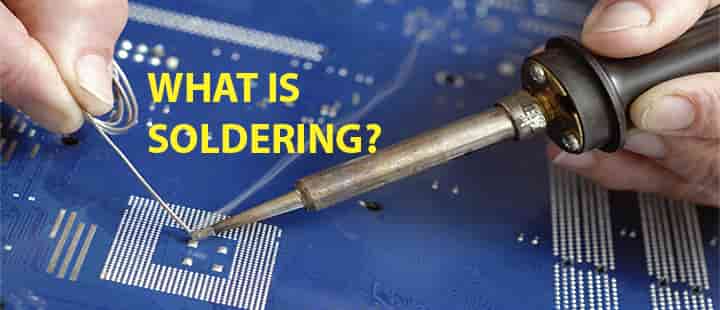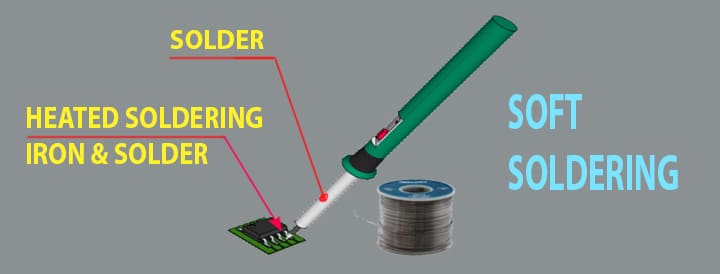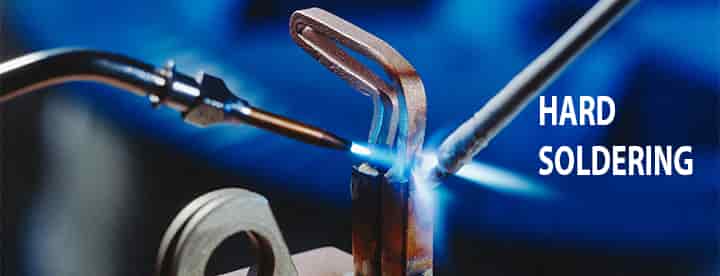What is soldering process, explained along with meaning, definition, flux, process, types, steps, advantages, disadvantages, etc. Also, we have covered a brief comparison of soldering vs brazing and soldering vs welding at the end. Let’s explore the soldering process!
What is Soldering?
Soldering Meaning & Basics
The soldering process is one of the metals joining processes. Basically, in this process, the two or more metals are joined together via melting and flowing a filler metal into the joint while the filler metal having a lower melting point than the adjoining metal.
- You may find it somewhat identical to the welding but it differs from the welding process.
- In case of the welding process, the metals are melted and then they are joined but in soldering the filler material is used.
- In brazing, the workpiece metal does not melt but the filler metal is the one that melts at a higher temperature than in soldering.

Don’t worry, we will see more about the difference between brazing and soldering processes later in this post.
History and origin of soldering
The brazing and soldering processes are believed to be originated long ago. It is believed that both the processes were started in Mesopotamia about 5000 years ago. Also, some goldsmiths of ancient Egypt knew how to join gold more than 5000 years ago. In ancient times, the products like jewellery products and cooking tools were made using soldering.
After that the modern technology adopted the soldering and improved day by day. The history of the soldering dates back to long old days. As this process was used from long ago its was way more popular. Let’s explore this one of the ancient known process soldering.
Soldering Definition & Process
The soldering process is simple to understand. Let’s know the brief working of the soldering process. Firstly, a solder made of,
- antimony,
- bismuth,
- brass,
- copper,
- indium,
- tin or
- silver which is free from lead is used.
The solder is melted using the heat from an iron connected to the temperature controller. The solder is heated to temperatures beyond its melting point. Then the solder cools by creating the soldered joint. One of the important parameters or part of the soldering process is the solder.
- The solder was made of lead earlier but due to regulations, they are now made of lead-free metals.
- As in the other processes like brazing, welding the flux is needed in the soldering process too.
- The impurities at the joint like oil, dirt, or oxidation are present.
- That’s the reason the soldering flux is needed for the soldering process.
You can explore welding basics
Soldering Flux
The flux is used for preventing the formation of oxides from forming while the metal is heated. Also, another work of the flux is to clean any contamination left on the brazing surfaces.
- The flux examples like traditionally used borax are one of them.
- Now some new fluxes are available like some active chemicals like fluorides.
- Flux can be applied in lots of ways.
- In ways like paste, liquid, powder, or pre-made brazing pastes.
- The flux flows into the joint of two metals to the heated joint and displaced by the molten filler metal entering the joint.
So, basically the main work of the flux is to facilitate the soldering process. The flux used in the soldering process is the rosin flux. This one helps in the mechanical strength and electrical contact of electrical joints. Also, it is sometimes possible to apply the wetting agent to reduce the surface tension. Let’s know a little bit more about the flux used in the soldering process.
Rosin Flux
The Rosin flux is one of the oldest fluxes used in the soldering process and is still used.
- The rosin flux is basically extracted from the pine trees.
- The active agents in the Rosin flux are abietic acid and plicatic acid.
So, the reaction between these two provides the mean for the flux, it removes provides the cleaning required for the soldering process.
Water soluble flux
This one is also a type of flux used in the soldering process. The water-soluble fluxes wash away when the board is washed with ordinary water mainly hot water.
No clean fluxes
The no clean fluxes leave very less residues which are not needed to be remove after soldering from finished assemblies. These fluxes vanish under the influence of heat. Now let’s know more about the types of soldering processes used usually. There are three types of the soldering process let’s check each type now.
Types of Soldering
Soft Soldering Process
The soft soldering process is generally used in the electronics and plumbing.

- This process creates an electrical connection.
- It helps to connect electronic components in the circuit boards.
- In all the soldering systems, it is the process in which the lowest metal melting point is what everyone uses.
- The fillers used in this process are generally the alloys.
- It often contains lead with a liquid temperature under 350 degrees Celsius.
The lower temperature used it will create a strong joint and when the higher temperature it will create less strength and will melt the bond.
Hard soldering
The hard soldering process uses an alloy consisting of silver. The temperature requirement for the hard soldering process is above the 450 degree Celsius.

- Hard soldering forms a strong connection than soft soldering.
- To strengthen the connection, it will require a blowtorch to increase the temperature and then melt the main metal used to create a strong joint known as the base metal.
- Hard soldering is used in small fittings. But this process is not sufficient for filling the gap thus the different fluxes are used for hard soldering.
- Hard soldering is also known as the silver soldering process.
Brazing
The brazing type of soldering acquires a higher melting point if we compare it with hard soldering or soft soldering. In this process, the material is needed to heat sufficiently to get the best outcome.
type of soldering acquires a higher melting point if we compare it with hard soldering or soft soldering. In this process, the material is needed to heat sufficiently to get the best outcome.
Desoldering Concept
As the word suggests the reverse of the soldering is the desoldering process.
- This process consists of the removal of the solder and components mounted on the circuit for repair purposes.
- This method comes in handy when the soldering is not done properly.
- Desoldering involves the use of a vacuum pump to remove solders from the plate through holes.
Now let’s check out the full process of the soldering process right from the start to the end.
Soldering Process Steps
The soldering operation can be easily understood with the steps. The operation is divided into the six steps. Let’s check out each one of them to understand the process of soldering in more depth.
Check a NICE VIDEO from Electronhacks,
Step-1 Cleaning
The first step of the soldering process is the cleaning process. The heated metals are prone to oxidise rapidly, the dust, dirt should be removed by chemical or mechanical actions. So, we will need to clean the tip of the solder and make it shiny, suitable for the operation.
- For effective cleaning, a damp sponge should be used.
- If we use the dry sponge it will not clean the tip well and if we wet one it will lower the temperature of the tip and hence making an ineffective solder joint.
Step-2 Heating
Obviously, the soldering depends upon the temperature. We will need to heat the soldering station. It can be adjusted to 350 degrees Celsius for achieving the required melting conditions.
Step-3 Insertion
In the insertion step the components which are to be soldered are inserted into holes of the circuit board.
- They are inserted by bending the lead using fine pliers.
- Then the leads protruding from the bottom will bend at an angle of 45 degrees angle.
Step-4 Soldering
Now the main step starts the soldering process is done in this step. By holding the soldering iron at 45 degree angle and keeping the solder wire in contact with space between iron tip and lead. The solder will melt around the joint. After the soldering is done instead of blowing off it should be allowed to cool naturally.
Step-5 Removal of residues
Now after the soldering is done the residues remain on the surface. If any flux is present there it will again start to react with that solder resulting in the harmful oxidation.
- The circuit board is to be cleaned with the brush and isopropyl alcohol.
- This step is important and must be done carefully.
Step-6 Finishing
The final step of the soldering process is the finishing. After cleaning process the process, the finishing process is to done. For more attractiveness and the surface is finished with the wax. Now we have known the process, types and other aspects of the soldering operation. Let’s start the advantages and disadvantages of the soldering process followed by applications.
Advantages of Soldering
Let’s try to know the advantages of the soldering process,
- Soldering can be used to join the dissimilar metals.
- The soldering process is simple, low cost, flexible.
- The user-friendliness of soldering makes it even better.
- The soldering can be done at low temperatures and controlling it is easy.
- The power requirement for heating of the soldering iron is low compared to other processes.
- The soldering process can be reversed using the desoldering process.
- Parts having variable thickness can be easily joined without burning and damaging them.
Disadvantages of Soldering
The disadvantages of soldering process, as follows
- The strength of the joint made by soldering is low compared to the process like welding or brazing.
- If high temperatures are used it may get damaged.
- When the long length parts are to be joined the soldering is not useful in this case.
- Heavy metals cannot be worked using soldering process.
- There are chances of toxic components at fluxes.
Applications of Soldering
Auto repairs: The soldering process is used in the auto repairs. It helps to tighten the joints and smoothen the surface. Though it can’t help with the heavy metals but it can be helpful in some parts.
Home projects: For connection of circuits and repairs the soldering process at home makes it way more useful. There are soldering guns and pencils available that can be easily used in home by anyone.
Plumbing: The attachment of copper to the plumbing pipes can be done using the lead free solder.
- Mounting of the electronic components of printed circuit boards.
- Jewellery making, cooking wares, tools stained glass works.
- Repair leakage in the containers.
- Soldering of vacuum tubes to form a sealant and insulate the housing parts in metal.
Is Soldering and Brazing Same?
Don’t be confused with brazing, Let’s check out the difference between soldering vs brazing in our different article. A short comparison is captured below to get an idea.
| Sr no | Soldering | Brazing |
| 1 | The soldering process is done at a temperature below 200 degrees Celsius. | The brazing process is done above the temperature of 450 degree Celsius. |
| 2 | The joints made in the soldering process are weaker compared to the brazing. | Brazing joints are strong as compared to the soldering. |
| 3 | Soldering is the cheaper process. | As compared to the soldering the brazing is costlier than soldering. |
| 4 | Solder is used in the soldering. | Spelter is used in the brazing. |
| 5 | Fluxes like zinc, rosin chlorides are used. | Fluxes like ash and borax are used. |
| 6 | Preheating of the base metal is not required. | The preheating of the metal is required to get some quality joints. |
| 7 | Soldered parts are to be cleaned with water. | Brazed parts are allowed to cool. |
Soldering vs Welding
Let’s check out the difference between soldering vs welding!
| Sr no | Soldering | Welding |
| 1 | In the soldering process, the workpiece or base metal is heated. | In welding process, base metal as well as fillers are melted. |
| 2 | The joints made in the soldering process are weaker compared to the welding. | Welding joints are strong as compared to the soldering. |
| 3 | Requires less temperature. | Requires high temperature. |
| 4 | Soldering is the cheaper process. | As compared to the soldering the welding is costlier than soldering. |
| 5 | Fluxes like zinc, rosin chlorides are used. | Fillers are used. |
| 6 | Preheating of the base metal is not required normally, but in case of high quality joint, preheating is required. | No preheating is required for welding. |
| 7 | Heat treatment is not required. | Heat treatment is required. |
Conclusion
So, we have got an idea about soldering process, its types, steps, advantages, disadvantages, etc. Any comments, please write in the comment box!

I truly enjoy reading through on this internet site, it contains good articles.